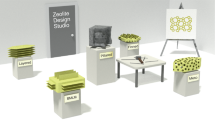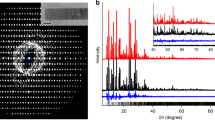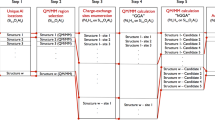Abstract
Today synthetic zeolites are the most important catalysts in petrochemical refineries because of their high internal surface areas and molecular-sieving properties1,2. There have been considerable efforts to synthesize new zeolites with specific pore geometries3,4, to add to the 167 available at present. Millions of hypothetical structures have been generated on the basis of energy minimization5, and there is an ongoing search for criteria capable of predicting new zeolite structures. Here we show, by geometric simulation6,7,8, that all realizable zeolite framework structures show a flexibility window over a range of densities. We conjecture that this flexibility window is a necessary structural feature that enables zeolite synthesis, and therefore provides a valuable selection criterion when evaluating hypothetical zeolite framework structures as potential synthetic targets. We show that it is a general feature that experimental densities of silica zeolites lie at the low-density edge of this window—as the pores are driven to their maximum volume by Coulomb inflation. This is in contrast to most solids, which have the highest density consistent with the local chemical and geometrical constraints.
This is a preview of subscription content, access via your institution
Access options
Subscribe to this journal
Receive 12 print issues and online access
$259.00 per year
only $21.58 per issue
Buy this article
- Purchase on Springer Link
- Instant access to full article PDF
Prices may be subject to local taxes which are calculated during checkout



Similar content being viewed by others
References
Bellussi, G. in Proc. 14th Int. Zeolite Conf., S. Africa (eds van Steen, E. W. J., Callanan, L. H., Claeys, M. & O’Connor, C. T.) (Rondebosch, South Africa, 2004).
Marcilly, C. Present status and future trends in catalysis for refining and petrochemicals. J. Catal. 216, 47–62 (2003).
Corma, A., Diaz-Cabanas, M., Martinez-Triquero, J., Rey, F. & Rius, J. A large-cavity zeolite with wide pore windows and potential as an oil refining catalyst. Nature 418, 514–517 (2002).
Degnan, T. The implications of the fundamentals of shape selectivity for the development of catalysts for the petroleum and petrochemical industries. J. Catal. 216, 32–46 (2003).
Treacy, M., Rivin, I., Balkovsky, E., Randall, K. & Foster, M. Enumeration of periodic tetrahedral frameworks. ii. Polynodal graphs. Micropor. Mesopor. Mater. 74, 121–132 (2004).
Gatta, G. & Wells, S. Rigid unit modes at high pressure: An explorative study of a fibrous zeolite-like framework with edi topology. Phys. Chem. Mineral 31, 1–10 (2004).
Wells, S., Dove, M. & Tucker, M. Finding best-fit polyhedral rotations with geometric algebra. J. Phys. Condens. Matter 14, 4567–4584 (2002).
Sartbaeva, A., Wells, S., Redfern, S., Hinton, R. & Reed, S. Ionic diffusion in quartz studied by transport measurements, SIMS and atomistic simulations. J. Phys. Condens. Matter 17, 1099–1112 (2005).
Baerlocher, C., Meier, W. & Olson, D. Atlas of Zeolite Framework Types (Elsevier, Amsterdam, 2001).
Phillips, J. Topology of covalent non-crystalline solids ii: Medium-range order in chalcogenide alloys and A—Si(Ge). J. Non-Cryst. Solids 43, 37 (1981).
Thorpe, M. Continuous deformations in random networks. J. Non-Cryst. Solids 57, 355–370 (1983).
Chubynsky, M. & Thorpe, M. Self-organization and rigidity in network glasses. Curr. Opin. Solid State Mater. Sci. 5, 525–532 (2001).
Baur, W. Self-limiting distortion by antirotating hinges is the principle of flexible but noncollapsible frameworks. J. Solid State Chem. 97, 243–247 (1992).
Donev, A., Torquato, S., Stillinger, F. & Connelly, R. Jamming in hard sphere and disk packings. J. Appl. Phys. 95, 989–999 (2004).
Bernal, J. & Carlisle, C. The range of generalized crystallography. Sov. Phys. Crystallogr. 13, 811–831 (1969).
O’Keeffe, M. On the arrangement of ions in crystals. Acta Crystallogr. A 33, 924–927 (1977).
Baerlocher, C., Hepp, A. & Meier, W. in DLS-76, a FORTRAN Program for the Simulation of Crystal Structures by Geometric Refinement (Institut fur Kristallographie and Petrographie, ETH, Zurich, 1978).
Baur, W. in Proc. 2nd Polish–German Zeolite Colloquium (ed. Rozwadowski, M.) 171–185 (1995).
Sani, A., Cruciani, G. & Gualtieri, A. Dehydration dynamics of ba-phillipsite: An in situ synchrotron powder diffraction study. Phys. Chem. Mineral. 29, 351–361 (2002).
Vezzalini, G., Alberti, A., Sani, A. & Triscari, M. The dehydration process in amicite. Micropor. Mesopor. Mater. 31, 253–262 (1999).
Gies, H. Studies on clathrasils. 6. crystal-structure of dodecasil-3c, another synthetic clathrate compound of silica. Z. Kristallogr. 167, 73–82 (1984).
Hrilijac, J., Eddy, M., Cheetham, A., Donohue, J. & Ray, G. Powder neutron-diffraction and Si-29 MAS NMR-studies of siliceous zeolite-Y. J. Solid State Chem. 106, 66–72 (1993).
Cruciani, G. & Gualtieri, A. Dehydration dynamics of analcime by in citu synchrotron powder diffraction. Am. Mineral. 84, 112–119 (1999).
Gatta, G., Nestola, F. & Ballaran, T. B. Elastic behavior, phase transition, and pressure induced structural evolution of analcime. Am. Mineral. 91, 568–578 (2006).
Binggeli, N. & Chelikowsky, J. Structural transformation of quartz at high pressures. Nature 353, 344–346 (1991).
Tsuchida, Y. & Yagi, T. New pressure-induced transformations of silica at room temperature. Nature 347, 267–269 (1990).
Caullet, P., Guth, J., Hazm, J., Lamblin, J. & Gies, H. Synthesis, characterization and crystal-structure of the new clathrasil phase octadecasil. Eur. J. Solid State Inorg. Chem. 28, 345–361 (1991).
Whiteley, W. Counting out to the flexibility of molecules. Phys. Biol. 2, S116–S126 (2005).
Zwijnenburg, M., Simperler, A., Wells, S. & Bell, R. Tetrahedral distortion and energetic packing penalty in zeolite frameworks: Linked phenomena? J. Phys. Chem. B 109, 14783–14785 (2005).
Gatta, G. & Wells, S. Structural evolution of zeolite levyne under hydrostatic and non-hydrostatic pressure: geometric modelling. Phys. Chem. Mineral. 33, 243–255 (2006).
Acknowledgements
This work was supported by NSF grants NIRT-0304391 and DMR-0425970. We acknowledge M. Foster for discussions.
Author information
Authors and Affiliations
Corresponding author
Ethics declarations
Competing interests
The authors declare no competing financial interests.
Supplementary information
Supplementary Information
Supplementary methods, notes and supplementary figures 1 and 2 (PDF 157 kb)
Rights and permissions
About this article
Cite this article
Sartbaeva, A., Wells, S., Treacy, M. et al. The flexibility window in zeolites. Nature Mater 5, 962–965 (2006). https://doi.org/10.1038/nmat1784
Received:
Accepted:
Published:
Issue Date:
DOI: https://doi.org/10.1038/nmat1784
This article is cited by
-
The Role of Zeolite Framework in Zeolite Stability and Catalysis from Recent Atomic Simulation
Topics in Catalysis (2022)
-
MEL zeolite nanosheet membranes for water purification: insights from molecular dynamics simulations
Journal of Nanostructure in Chemistry (2022)
-
The effect of pressure on open-framework silicates: elastic behaviour and crystal–fluid interaction
Physics and Chemistry of Minerals (2018)
-
In situ solid-state NMR and XRD studies of the ADOR process and the unusual structure of zeolite IPC-6
Nature Chemistry (2017)
-
Calculation of pore diameters in zeolites
Theoretical Chemistry Accounts (2017)



